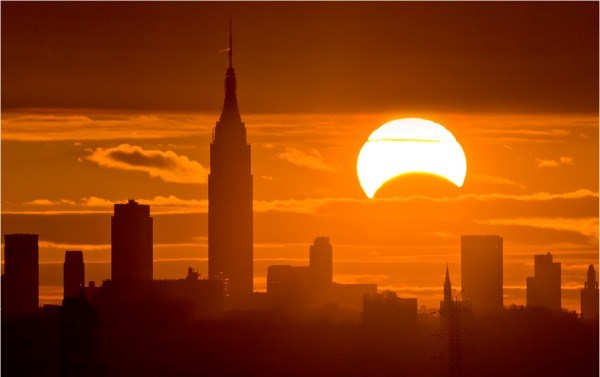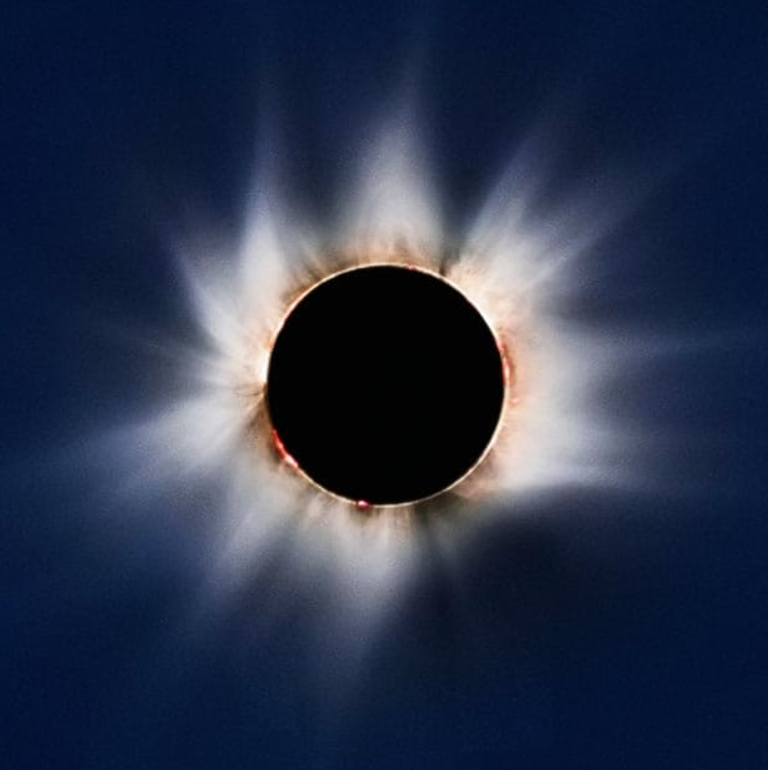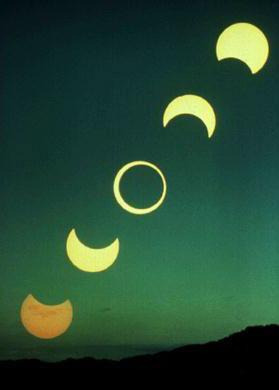
Total Solar Eclipse 2017: Everything You Need to Know
Phil Kesten
On Aug. 21, 2017, the United States will darken as we witness a total solar eclipse. What are solar eclipses, and what can we learn from them?
The sun, Earth, and the moon all stay essentially on one, flat “surface” in space. That means the moon can sometimes move into a position directly between the sun and Earth. When this happens, Earth passes through the shadow cast by the moon. If you are in the path of that shadow, some or all of the sun’s disk will be obscured.
A solar eclipse can result in spectacular sights, like the one New Yorkers were treated to on the morning of Nov. 3, 2013. The moon was already covering part of the sun (a partial eclipse) as it rose over the Atlantic, eventually blocking the sun’s entire disk (a total eclipse).

Partial eclipse over New York, Nov. 3, 2013, captured by Chris Cook Photography
The moon’s shadow is only about a hundred miles wide where it hits Earth, which is too small to cover the entire planet. So unlike a lunar eclipse, a solar eclipse is not visible from everywhere on Earth. In addition, from many vantage points on Earth the moon will obscure only part of the sun.
Monday’s total solar eclipse will be visible along a swath about a hundred miles wide, stretching from the Oregon coast to South Carolina. The moon’s shadow will race across the U.S. in about 90 minutes, starting around 10:15 a.m. local time in Oregon. Observers along the path of the moon’s shadow will see the sun’s disk completely obscured by the moon for about 2 minutes. Before and after totality, the disk of the moon will gradually cover and then uncover the sun. Depending on where you are, it could be as long as 2 hours and 40 minutes from when the eclipse begins until it’s over.
Even if you are not along the path of totality during the solar eclipse, the moon will cover at least 40 percent of the sun’s disk for observers everywhere in North America. In California, we won’t be able to see a total solar eclipse, but we will see a partial eclipse. You can find more real-time information about the Aug. 21, 2017 solar eclipse on NASA’s website.
If you’re lucky enough to see the total eclipse, you’ll be treated to a sight that is both spectacular and of great interest to scientists. It is only when the bright disk of the sun is covered that we can see its corona, a halo that surrounds the sun. We normally can’t see it directly because the corona is faint in comparison to the bright sun.

A total solar eclipse, showing solar flares and prominences past the limb of the Sun, which is blocked by the Moon, and the solar corona. Photo: Jay Pasachoff/Science Faction/Corbis
The corona extends outward 100 million miles or more from the sun. It is marked by frequent explosions, or solar flares, which propel enormous quantities of gas into space at up to 4 million miles per hour. Scientists still don’t completely understand these flares, for example, why they occur or why the temperature of the gas—2 million degrees (Fahrenheit)—is so much hotter than on the surface of the sun. We are always excited to observe and study the sun’s corona.
If the moon were smaller than the sun in appearance, it could never block out the entire sun. If it were bigger, we might have not discovered the sun’s corona. Is there a scientific reason that the sun and moon are the same apparent size? No. It’s just a happy coincidence. The moon is 400 times smaller than the sun, but it’s about 400 times closer, so the moon and the sun appear to be the same size when viewed from Earth.
And really, the sun and moon are not always the same apparent size. Earth’s path around the sun is not a perfect circle, so Earth is sometimes closer to the sun and sometimes farther away. When we’re closer, the sun’s apparent size is bigger and the moon cannot completely cover it, resulting in an annular eclipse.

Annular eclipse
Unlike lunar eclipses, total solar eclipses are rare. In the past 100 years, there have been hundreds of lunar eclipses, but only about 70 total solar eclipses. And while a lunar eclipse can be seen anywhere on Earth, the path of a solar eclipse on Earth is short and narrow.
When you observe a solar eclipse, do not look directly at the sun, not even for a moment! Staring at the sun, directly or through one or more pairs of sunglasses, can permanently burn your retinas. The best ways to enjoy the solar eclipse are to use special approved glasses, or to make a pinhole camera. If you want to use glasses, however, you should note that most welder’s goggles are not dark enough to protect your eyes. The lenses must be “shade 14” or darker.
To make a pinhole camera, tape a piece of aluminum foil over a quarter-sized hole in a piece of cardboard, punch a small hole in the foil with a pin, and hold the cardboard up to project an image of the sun on the ground or a wall. Scientists at NASA’s Jet Propulsion Lab have created a web page that explains how to make a pinhole camera.
-----------------------------------------
Questions to ponder:
The night before a solar eclipse, is there a full moon, a new moon, or a crescent moon?

